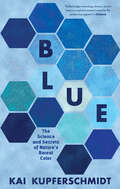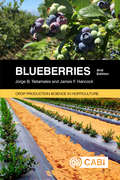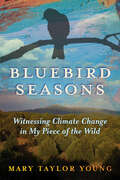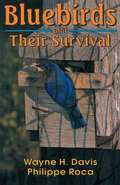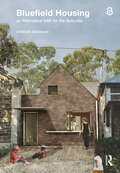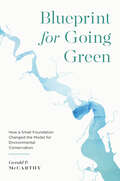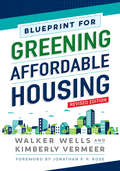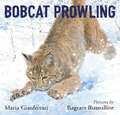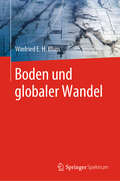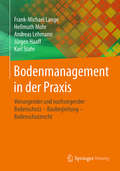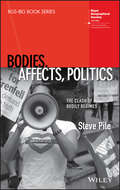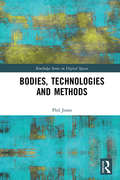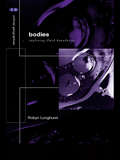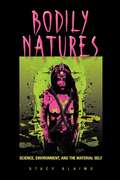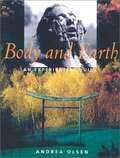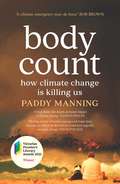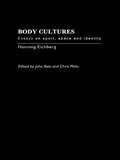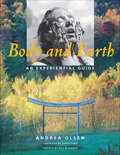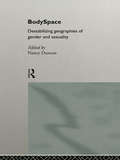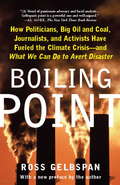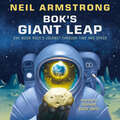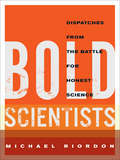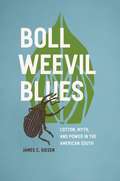- Table View
- List View
Blue: The Science And Secrets Of Nature's Rarest Color
by Kai KupferschmidtWhat is it about the color blue? Blue is our favorite color globally—the darling of artists since the time of the pharaohs. So it’s startling to turn to the realms of nature and discover that “true” blue is truly rare. The sea and sky are blue, but we can’t bottle this trick of physics. And the few creatures, plants, and minerals that appear blue are almost all deceiving us. There’s no blue pigment in a blue jay—it would be brown but for how its feathers distort light. Kai Kupferschmidt has been enraptured by blue since childhood. In Blue, he invites readers on his globe-trotting quest to understand his favorite color— from Kyoto, where scientists are trying to engineer a blue rose, to Brandenburg, where conservationists hope to save the “little blue macaw.” Deep underground where blue crystals grow and miles overhead where astronauts gaze at our “blue marble” planet-wherever he finds this alluring color, it has a story to tell.
Blueberries 2nd Edition (Crop Production Science In Horticulture)
by Jorge B. RetamalesThis new and updated edition covers major topics of interest to blueberry breeders and researchers: botany, physiology, nutrition, growth regulation, photosynthesis, environment, weeds, pests, diseases and postharvest management. The focus is on the highbush blueberry, though information on other blueberries and related species is also provided. <P><P>Blueberries are cultivated worldwide and this book explores plantings in a great diversity of environments, reflecting on the development of innovative cultural practices and conditions. It examines the increased scope and depth of research activities related to this crop and brings together the current status of knowledge on blueberry science and management. Explaining in an understandable manner the basic science behind the growth and development of blueberries, their botanical characteristics, as well as the implications and effects of various management practices and environmental conditions, the second edition of Blueberries also: <P><P> • Highlights emerging genetic information on the blueberry • Includes new information on pruning, grafting and irrigation • Covers current and potential uses of plant growth regulators • Gathers new information on fruit quality and consumer acceptance <P><P>Key Features: <P><P> • The definitive guide to blueberry cultivation for researchers, growers and breeders • Updated to reflect the latest developments in the industry • Comprehensive coverage of botanical, physiological and management of cultivated blueberries
Bluebird Seasons: Witnessing Climate Change in My Piece of the Wild
by Mary Taylor YoungIn this A Sand County Almanac for the twenty-first century, nature writer and zoologist Mary Taylor Young tells the story of the growing effects of climate change on her land in the pine-covered foothills of southern Colorado. Climate change wasn't yet on the public radar when Young and her husband bought their piece of the wild in 1995. They built a cabin and set up a trail of bluebird nest boxes, and Mary began a nature journal of her observations, delighting in the ceaseless dramas, joys, and tragedies that are the fabric of life in the wild. But changes greater than the seasonal cycles of nature became evident over time: increasing drought, trees killed by plagues of beetles, wildfires, catastrophic weather, bears entering hibernation later and thinner, the decline of some familiar birds, and the appearance of new species. Their journal of sightings over twenty-five bluebird seasons, she realized, was a record of climate change happening, not in an Indonesian rainforest or on an Antarctic ice sheet but in their own natural neighborhood. Using the journal as a chronicle of change, Young tells a story echoed in everyone's lives and backyards. But it's not time to despair, she writes. It's time to act. Young sees hope in the human ability to overcome great obstacles, in the energy and determination of young people, and in nature's resilience, which the bluebirds show season after season.
Bluebirds and Their Survival: and Their Survival
by Wayne H. Davis Philippe RocaBring more bluebirds into your life with this “lavishly illustrated [and] easy-to-read” how-to book (Manchester Enterprise).Bluebird expert Wayne H. Davis tells how to attract and care for this beautiful and gentle bird and offers solutions to the most common bluebird problems. Since bluebirds are almost entirely dependent on people for providing nesting sites, the book contains plans for erecting a structure that will attract bluebirds to a safe habitat. Instructions for building and maintaining a “bluebirds trail,” complete with drawings of various bluebirds houses and guards against predators, are also included. Davis shares his plans for his specially designed Kentucky Bluebird Box?a unique bird house attractive to the Eastern Bluebird but unsuitable for the bluebird’s rivals?as well a variety of other plans for using materials as inexpensive as milk cartons and scavenged pipes. A chapter by professional photographer Philippe Roca offers tips on photographing bluebirds. Whether you’re a beginning birder or an expert, Davis will help ensure your success in attracting and raising bluebirds.“To ensure the survival of bluebirds (a North American native threatened by sparrows and starlings), the authors instruct on how to build habitats, distribute winter feed, and foil enemies, both feathered and furred. Scientific research is cited to back the authors’ claims on the best diet, nesting locations, and shelters. Finally offered are photography lessons and specific birdhouse designs, from simple milk jugs to a sparrow-inhibiting nest box. Bird-watchers, earnest and casual, will benefit from this guide.” —Booklist
Bluefield Housing as Alternative Infill for the Suburbs
by Damian MadiganSuburbanised cities share a common dilemma: how to transition to more densely populated and socially connected urban systems while retaining low-rise character, avoiding gentrification, and opening neighbourhoods to more diverse housing choices. Bluefield Housing offers a new land definition and co-located infill model addressing these concerns, through describing and deploying the types of ad-hoc modifications that have been undertaken in the suburbs for decades. Extending green-, brown-, and greyfield definitions, it provides a necessary middle ground between the ‘do nothing’ attitude of suburban preservation and the ‘do everything’ approach of knock-down-rebuild regeneration. An adjunct to ‘missing middle’ and subdivision densification models, with a focus on co-locating homes on small lots, Bluefield Housing presents a unified design approach to suburban infill: retrofitting original houses, retaining and enhancing landscape and urban tree canopies, and delivering additional homes as low-rise additions and backyard homes suited to the increasingly complex make-up of our households. Extensively illustrated by the author with engaging architectural design studies, Damian Madigan describes how existing quirks of suburban housing can prompt new forms of infill, explains why a new suburban densification model is not only necessary but can be made desirable for varied stakeholders, and charts a path towards the types of statutory and market triggers required to make bluefield housing achievable. Using Australian housing as an example but addressing universal concerns around neighbourhood character, demographic needs, housing diversity, dwelling flexibility, and landscape amenity, Bluefield Housing offers innovative suburban infill ideas for policy makers, planners, architects, researchers and students of housing and design studies, and for those with a stake in the future of the suburbs.
Bluefield Housing as Alternative Infill for the Suburbs
by Damian MadiganSuburbanised cities share a common dilemma: how to transition to more densely populated and socially connected urban systems while retaining low-rise character, avoiding gentrification, and opening neighbourhoods to more diverse housing choices. Bluefield Housing offers a new land definition and co-located infill model addressing these concerns, through describing and deploying the types of ad-hoc modifications that have been undertaken in the suburbs for decades. Extending green-, brown-, and greyfield definitions, it provides a necessary middle ground between the ‘do nothing’ attitude of suburban preservation and the ‘do everything’ approach of knock-down-rebuild regeneration.An adjunct to ‘missing middle’ and subdivision densification models, with a focus on co-locating homes on small lots, Bluefield Housing presents a unified design approach to suburban infill: retrofitting original houses, retaining and enhancing landscape and urban tree canopies, and delivering additional homes as low-rise additions and backyard homes suited to the increasingly complex make-up of our households.Extensively illustrated by the author with engaging architectural design studies, Damian Madigan describes how existing quirks of suburban housing can prompt new forms of infill, explains why a new suburban densification model is not only necessary but can be made desirable for varied stakeholders, and charts a path towards the types of statutory and market triggers required to make bluefield housing achievable. Using Australian housing as an example but addressing universal concerns around neighbourhood character, demographic needs, housing diversity, dwelling flexibility, and landscape amenity, Bluefield Housing offers innovative suburban infill ideas for policy makers, planners, architects, researchers and students of housing and design studies, and for those with a stake in the future of the suburbs.The Open Access version of this book, available at www.taylorfrancis.com, has been made available under a Creative Commons Attribution-Non Commercial-No Derivatives (CC-BY-NC-ND) 4.0 license.
Blueprint for Going Green: How a Small Foundation Changed the Model for Environmental Conservation
by Gerald P. McCarthyHow one organization took on industrial pollution—and the lessons for our new century In 1977, one forward-thinking judge took an ecological disaster—the poisoning of the James River by Allied Chemical—and turned it into a great environmental-protection legacy. The $8 million payment made by Allied would go on to fund the game-changing Virginia Environmental Endowment.Blueprint for Going Green provides an insider&’s account of the remarkable results of this landmark ruling and the foundation it spawned. Over the following decades, the VEE helped to grow the fledgling environmental movement in Virginia into a powerful force for protecting the state&’s water quality and conserving its landscape. This inspiring story reveals how a small group can make a profound difference by engaging in public policy work, funding science to advance public policy, and helping to build a lasting and effective citizen-led environmental movement. Finalist for the Southern Environmental Law Center's Phillip D. Reed Environmental Writing Award
Blueprint for Greening Affordable Housing, Revised Edition
by Walker Wells Kimberly VermeerBlueprint for Greening Affordable Housing is the most comprehensive resource on how green building principles can be incorporated into affordable housing design, construction, and operation. In this fully revised edition, Walker Wells and Kimberly Vermeer capture the rapid evolution of green building practices and make a compelling case for integrating green building in affordable housing. The Blueprint offers guidance on innovative practices, green building certifications for affordable housing, and the latest financing strategies. The completely new case studies share detailed insights on how the many elements of a green building are incorporated into different housing types and locations. Every affordable housing project can achieve the fundamentals of good green building design. The Blueprint gives project teams what they need to push for excellence.
Bob Flame Rocky Mountain Ranger
by Dorr G. YeagerThis is a classic novel of the early days of the National Park Service, when just what park rangers did was not known to many people. Thrilling mountain rescues, dangerous skirmishes with poachers and bootleggers, ski patrols high above timberline, It's just another day in the "office" for Bob Flame Rocky Mountain Ranger.
Bobcat Prowling
by Maria GianferrariIn this companion to Coyote Moon and Hawk Rising, a young bobcat searches a suburban landscape for a territory to call home.As the day breaks,feline eyes blink open,and yowls disrupt the still morning air.A young bobcat leaves tracks in the snow as he sets out to find a home range of his own. Amidst the harsh winds and icy chill of winter, Yearling travels between the deep wilderness and suburbia, hunting for prey as he goes. He tracks hare, squirrel, pheasant…Watching. Waiting. LEAP!But each time, he is foiled by the resident predator. Will Yearling find a territory to call his own?
Boden und globaler Wandel
by Winfried E. BlumKönnen Sie sich vorstellen, wie wir uns in Zukunft ernähren und ob wir in 30 Jahren noch genügend Nahrung produzieren können, ob wir noch genügend sauberes Wasser zur Verfügung haben werden und wie die biologische Vielfalt unserer unmittelbaren natürlichen Umgebung aussehen wird? Wir leben zwar auf dem Boden, haben jedoch selten eine Vorstellung davon, wie dieser unter unseren Füßen aussieht und welche Funktionen er für uns und unsere Umwelt erfüllt und wie diese durch weltweite Veränderungen beeinflusst werden. Wussten Sie, dass der Boden unmittelbar die Atmosphäre und damit auch den Klimawandel beeinflusst, oder, dass die Zusammensetzung der Salze in den Weltmeeren durch die Verwitterung der Gesteine und durch die Bodenbildung auf den Kontinenten bestimmt ist? Wussten Sie, dass das Überleben der Ureinwohner des Amazonasgebietes Südamerikas nur möglich war, weil sie sich eigene, neue Böden geschaffen haben, die „Schwarzerde der Indianer“? Und wussten Sie, dass wir heute in Europa täglich wertvolle Bodenflächen in der Größenordnung von ca. 850 Fußballfeldern durch den Bau von Wohnungen, Industrieanlagen, Straßen, u. a. versiegeln? Diese und zahlreiche weitere Informationen bietet Ihnen dieses Buch, das die Böden und ihre weltweite Verbreitung sowie ihre Funktionen für Mensch und Umwelt beschreibt, und Ihnen einen Einblick in die globalen Veränderungen der Land- und Bodennutzung und deren Ursachen und Wirkungen ermöglicht.
Bodenmanagement in der Praxis: Vorsorgender und nachsorgender Bodenschutz – Baubegleitung – Bodenschutzrecht
by Karl Stahr Frank-Michael Lange Hellmuth Mohr Andreas Lehmann Jürgen HaaffDie wichtigsten Gesetze und Verordnungen werden vorgestellt und die Rechtslage an Hand aktueller Rechtssprechung dargelegt. Erkundungs- und Bewertungstechniken werden beschrieben und kommentiert und die relevanten Normen und technischen Regelwerke sind aufgef#65533;hrt. Das Buch gliedert sich in die drei Bereiche Altlasten, Abfalltechnik - soweit Bodenkundlich relevant - und Oberbodenmanagement. Letzteres wird im Zuge von Ausgleichsma#65533;nahmen zu Bauvorhaben vermehrt von zust#65533;ndigen Beh#65533;rden eingefordert.
Bodies, Affects, Politics: The Clash of Bodily Regimes (RGS-IBG Book Series)
by Steve PileThis book seeks to understand the coexistence of bodily regimes and the politics that emerge from the clash between them: Presents a novel conceptual model for understanding the relationship between bodies and affects Reworks Rancière's notions of the distribution of the sensible and the aesthetic unconscious Establishes a dynamic and multiple understanding of the repressive, distributive and communicative unconscious by rethinking Freudian psychoanalysis Utilizes a variety of empirical materials, from Hollywood movies to Freud's case studies Sets its argument about politics within the context of significant social events to ensure its conceptual and empirical material is relevant to the contemporary political moment
Bodies, Technologies and Methods (Routledge Series on Digital Spaces)
by Phil JonesThis book examines how different technologies can be used to enhance research methods in the social sciences and humanities. The boundary between the body and the digital has become increasingly blurred in recent years due to the rise of technologies that capture and reshape our embodied selves. New technologies all too often reflect the attitudes of the privileged white men who dominate the tech sector. This book thus, in part, considers how critical researchers can employ new technologies while challenging some of the problematic assumptions that underpin their design. It also includes a series of case studies that examine the dynamic use of different techniques to explore key questions around the intersection of embodiment and the digital. With a playful, experimental approach to conducting research today, this book offers new, cutting-edge methods that respond to the potential of different technologies. It will be invaluable reading for undergraduate and post-graduate students of social sciences and humanities to explore ways in which this approach can bring new insights to a range of interdisciplinary research questions.
Bodies: Exploring Fluid Boundaries (Critical Geographies)
by Robyn LonghurstThis is one of the first books to introduce students to the key concepts and debates surrounding the relationship between bodily boundaries, abject materiality and spaces. The text includes original interview and focus group data informed by feminist theory on the body and uses case studies to illustrate the social construction of bodies. It will critically engage students in topical questions around sexuality, cultural differences and women's sub-ordination to men.
Bodily Natures: Science, Environment, And The Material Self
by Stacy AlaimoHow do we understand the agency and significance of material forces and their interface with human bodies? What does it mean to be human in these times, with bodies that are inextricably interconnected with our physical world? Bodily Natures considers these questions by grappling with powerful and pervasive material forces and their increasingly harmful effects on the human body. Drawing on feminist theory, environmental studies, and the sciences, Stacy Alaimo focuses on trans-corporeality, or movement across bodies and nature, which has profoundly altered our sense of self. By looking at a broad range of creative and philosophical writings, Alaimo illuminates how science, politics, and culture collide, while considering the closeness of the human body to the environment.
Body And Earth: An Experiential Guide
by Andrea Olsen Bill McKibben Caryn McHose“Body is our first environment,” writes Andrea Olsen. “It is the medium through which we know the earth.” In a remarkable integration of environmental science, biology, meditation, and creative expression, Olsen, a dancer who teaches in the environmental studies program at Middlebury College, offers a guide to a holistic understanding of person and place. Part workbook, part exploration, Body and Earth considers the question of how we can best, most responsibly inhabit both our bodies and our planet. Olsen displays an easy command of fields as diverse as geology, biochemistry, ecology, and anatomy as she explores the ways in which our bodies are derived from and connected to the natural world. But Body and Earth is not just a lesson, it is also an investigation. Arranged as a 31-day program, the book offers not only a wealth of scientific information, but also exercises for both exploring the body and connecting with place; illustrations and works of art that illuminate each chapter’s themes; and Olsen’s own meditations and reflections, connecting the topics to her personal history and experience. Olsen insists that neither body nor landscape are separate from our fundamental selves, but in a culture which views the body as a mechanism to be trained and the landscape as a resource to be exploited, we need to learn to see again their fundamental wholeness and interconnection. Through hard data, reflection, exercises, and inspiration, Body and Earth offers a guide to responsible stewardship of both our planet and our persons.
Body Count: How Climate Change is Killing Us
by Paddy ManningSuddenly, when the country caught fire, people realised what the government has not: that climate change is killing us.But climate deaths didn&’t start in 2019. Medical officers have been warning of a health emergency as temperatures rise for years, and for at least a decade Australians have been dying from the plagues of climate change – from heat, flood, disease, smoke. And now, pandemic.In this detailed, considered, compassionate book, Paddy Manning paints us the big picture. He revisits some headline events which might have faded in our memory – the Brisbane Floods of 2011; Melbourne&’s thunderstorm asthma fatalities of 2016 – and brings to our attention less well-publicised killers: the soil-borne diseases that amplify after a flood; the fact that heat itself has killed more people than all other catastrophes put together. In each case, he has interviewed scientists to explore the link to climate change and asks how – indeed, whether – we can better prepare ourselves in the future.Most importantly, Manning has spoken to survivors and the families of victims, creating a monument to those we have already lost. Donna Rice and her 13-year-old son Jordan. Alison Tenner. The Buchanan family. These are stories of humans at their most vulnerable, and also often at their best. In extremis, people often act to save their loved ones above themselves. As Body Count shows, we are now all in extremis, and it is time to act.Respected journalist Paddy Manning tells these stories of tragedy and loss, heroism and resilience, in a book that is both monument and warning. &‘A climate emergency tour de force.' Dr Bob Brown 'True stories of heroism and unimaginable loss...Body Count is a brilliant exposition of why we must deal with the climate problem now.' Ross Garnaut 'Climate change kills. … Through the accounts of people who have lost so much, Paddy Manning drives home the deeply personal impact of climate change. Governments continue to ignore the impact on climate change on human health at OUR peril. The future of our planet and our future generations depends on everyone playing their part, today.' Professor Kerryn Phelps 'A stunningly powerful call to political leaders everywhere who hear the warnings of the devastating impacts of climate change on health but fail to act.' Dr Helen Haines, independent member for Indi &‘Moving stories of heroic courage and tragic loss. A pause to reflect on the lives lost and how urgently we need change.&’ David Pocock, former Wallabies captain
Body Cultures: Essays on Sport, Space & Identity by Henning Eichberg
by John BaleBody Cultures explores the relationship between the body, sport and landscape. This book presents the first critically edited collection of Henning Eichberg's provocative essays into 'body culture'. Eichberg, a well-known scholar in continental Europe who draws upon the ideas of Elias, Focault, Habermas and others, is now attracting considerable interest from Anglo-American sociologists, historians and geographers. This collection has been extensively edited to highlight Eichberg's most important arguments and themes. Introductory essays from the editors and Susan Brownell provide clear explanations and interpretations as well as a biography of Eichberg.
Body and Earth: An Experiential Guide (Middlebury Bicentennial Series In Environmental Studies)
by Andrea Olsen"Body is our first environment," writes Andrea Olsen. "It is the medium through which we know the earth." In a remarkable integration of environmental science, biology, meditation, and creative expression, Olsen, a dancer who teaches in the environmental studies program at Middlebury College, offers a guide to a holistic understanding of person and place. Part workbook, part exploration, Body and Earth considers the question of how we can best, most responsibly inhabit both our bodies and our planet. Olsen displays an easy command of fields as diverse as geology, biochemistry, ecology, and anatomy as she explores the ways in which our bodies are derived from and connected to the natural world. But Body and Earth is not just a lesson, it is also an investigation. Arranged as a 31-day program, the book offers not only a wealth of scientific information, but also exercises for both exploring the body and connecting with place; illustrations and works of art that illuminate each chapter's themes; and Olsen's own meditations and reflections, connecting the topics to her personal history and experience. Olsen insists that neither body nor landscape are separate from our fundamental selves, but in a culture which views the body as a mechanism to be trained and the landscape as a resource to be exploited, we need to learn to see again their fundamental wholeness and interconnection. Through hard data, reflection, exercises, and inspiration, Body and Earth offers a guide to responsible stewardship of both our planet and our persons.
BodySpace: Destabilising Geographies of Gender and Sexuality
by Nancy DuncanBodySpace brings together some of the best known geographers writing on gender and sexuality today. Together they explore the role of space and place in the performance of gender and sexuality. The book takes a broad perspective on feminism as a theoretical critique, and aims to ground - and destabilize - notions of citizenship, work, violence, "race" and disability in their geographical contexts. The book explores the idea of knowledge as embodied, engendered and embedded in place and space. Gender and sexuality are explored - and destabilized - through the methodological and conceptual lenses of cartography, fieldwork, resistance, transgression and the divisions between local/global and public/private space. Contributors: Linda Martin Alcoff, Kay Anderson, Vera Chouinard, Nancy Duncan, J.K. Gibson-Graham, Ali Grant, Kathleen Kirby, Audrey Kobayashi, Doreen Massey, Linda McDowell, Wayne Myslik, Heidi Nast, Gillian Rose, Joanne Sharp, Matthew Sparke, Gill Valentine
Boiling Point: How Politicians, Big Oil and Coal, Journalists, and Activists Have Fueled a Climate Crisis -- And What We Can Do to Avert Disaster
by Ross GelbspanIn Boiling Point, Ross Gelbspan argues that, unchecked, climate change will swamp every other issue facing us today. Indeed, what began as an initial response of many institutions--denial and delay--has now grown into a crime against humanity. The fossil fuel industry is directing the Bush administration's energy and climate policies-payback for helping Bush get elected. But they're not the only ones to blame: the media and environmental activists are unwittingly worsening the crisis. In his new introduction, Gelbspan reveals that the outlook isn't getting better. The climate continues to change with increasing acceleration: hurricanes devastated Florida; rainfall patterns left two million people starving in Kenya; 2004 was the fourth hottest year on record. At the same time, the coal industry was planning to sabotage an effort in the Senate to begin to regulate carbon dioxide. Officials of Switzerland, France, and Canada said last year that, when the Kyoto Protocol takes effect, they intend to take the United States to court under the World Trade Organization, reasoning that the U. S. 's refusal to lower their carbon emissions amounts to an illegal subsidy-a "carbon subsidy"-on its exports. With the reelection of George W. Bush and a Republican-controlled congress, Boiling Point is more imperative than ever. Both a passionate call-to-arms and a thoughtful roadmap for change, Gelbspan reveals what's at stake for our fragile planet.
Bok's Giant Leap: One Moon Rock's Journey Through Time and Space
by Neil ArmstrongFirst man on the moon Neil Armstrong's only children's book is a unique exploration of how the Earth and the Moon came to be.The entire epic history of the Earth and the Moon is recounted through the observations of one special moon rock named Bok. Geologists say that rocks remember, and Bok certainly does. It recounts how its life began on Earth, until a collision with an asteroid catapults it into orbit during the creation of the Moon. From the Moon's surface, Bok watches the developing planet change from afar--until a strange creature scoops him up and brings him back to Earth. When NASA honored Apollo 11 astronaut Neil Armstrong and gave him a piece of moon rock from that mission, Armstrong playfully named the rock Bok in his acceptance speech. Award-winning illustrator Grahame Baker-Smith has created a breathtaking, one-of-a-kind picture book based on that speech, combining fascinating science and history with the grandest human adventure of all.
Bold Scientists: Dispatches from the Battle for Honest Science
by Michael RiordonAs governments and corporations scramble to pull the plug on research that proves that they are poisoning our planet and rush to muzzle the scientists who dare to share their disturbing data, it seems the powerful have declared a war on science. Michael Riordon asks deep questions of bold scientists who defy the status quo including: an Indigenous biologist who integrates traditional knowledge and a trickster’s wit; an engineering professor who exposes the myths and dangers of fracking; a forensic geneticist who traces children stolen by the military in El Salvador; a sociologist who investigates the lure and threat of mass surveillance; a radical psychologist who confronts psychiatry’s dangerous power; and a young marine biologist who risks her career to defend science and democracy. Who controls science and at what cost to the earth and its inhabitants? Can we change? This is unspun science for dangerous times.
Boll Weevil Blues: Cotton, Myth, and Power in the American South
by James C. GiesenBetween the 1890s and the early 1920s, the boll weevil slowly ate its way across the Cotton South from Texas to the Atlantic Ocean. At the turn of the century, some Texas counties were reporting crop losses of over 70 percent, as were areas of Louisiana, Arkansas, and Mississippi. By the time the boll weevil reached the limits of the cotton belt, it had destroyed much of the region’s chief cash crop—tens of billions of pounds of cotton, worth nearly a trillion dollars. As staggering as these numbers may seem, James C. Giesen demonstrates that it was the very idea of the boll weevil and the struggle over its meanings that most profoundly changed the South—as different groups, from policymakers to blues singers, projected onto this natural disaster the consequences they feared and the outcomes they sought. Giesen asks how the myth of the boll weevil’s lasting impact helped obscure the real problems of the region—those caused not by insects, but by landowning patterns, antiquated credit systems, white supremacist ideology, and declining soil fertility. Boll Weevil Blues brings together these cultural, environmental, and agricultural narratives in a novel and important way that allows us to reconsider the making of the modern American South.
